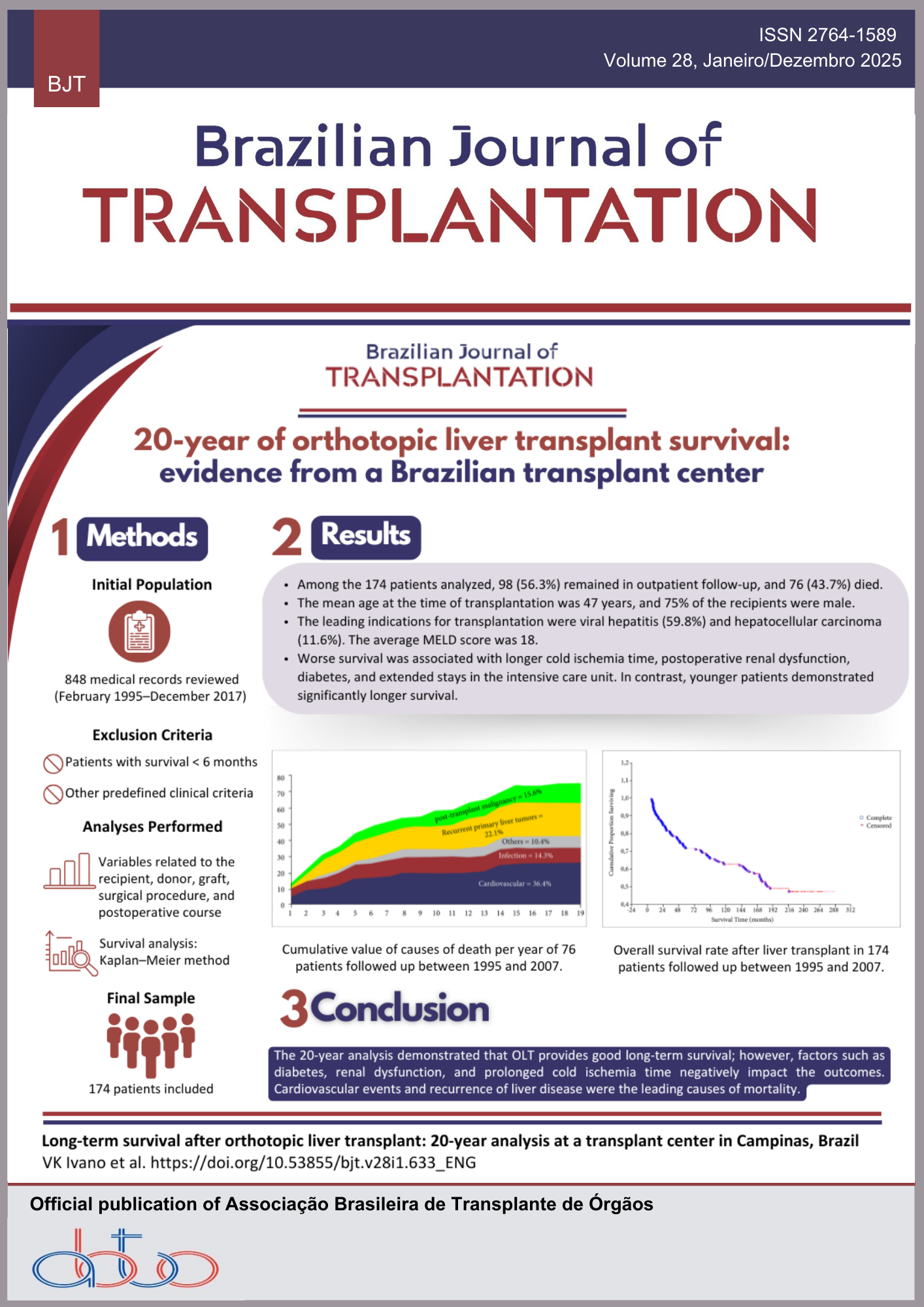Non-Necrotizing Acute Dermohypodermal Infections in Cirrhotic Patients Being Evaluated for Liver Transplantation
Keywords:
Bacterial Infections, Soft Tissue, Cirrhosis, Immunodeficiency, MortalityAbstract
Introduction: Infections in cirrhotic patients have a significant impact on morbidity and mortality, but little is known about acute non-necrotizing dermohypodermal infections (erysipelas and infectious cellulitis) in this population. The high mortality in this group also represents a loss of opportunity for liver transplantation, which could be a potential solution for these patients. Objectives: This study aims to describe the clinical characteristics, evolution, and outcomes of cirrhotic patients with acute non-necrotizing dermohypodermal infections under evaluation for liver transplant. Methods: A retrospective study was conducted on patients hospitalized with cirrhosis and dermohypodermal infections from 2010 to 2012. Results: Among 983 patients with liver cirrhosis, leading to 2,046 consultations for decompensated cirrhosis, dermohypodermal infections were identified in 65 (7%) cases. The mean age was 58 years (± 10), with 82% male. Cellulitis predominantly affected the lower limbs (70%), followed by the trunk (21%) and upper limbs (9%). Alcoholic liver disease was the primary etiology (56%), followed by alcohol and hepatitis C (17%), isolated hepatitis C (13%), non-alcoholic steatohepatitis (9%), and hepatitis B (3%). Based on the Child-Pugh score, 8% were classified as class A, 46% as class B, and 46% as class C. The average model for end-stage liver disease (MELD) score was 20 (± 8). Commonly associated infections included urinary tract infection (54%), pneumonia (25%), and spontaneous bacterial peritonitis (21%). Prescribed antibiotics were clindamycin (71%), cephalosporins (40%), oxacillin (18%), penicillin (11%), vancomycin (11%), quinolones (4.5%), and other antibiotics (15.3%). Sepsis occurred in 14% of cases, and the mortality rate was 18.5% (n=12). Among the deceased patients, 67% (n=8) had concomitant infections with cellulitis. Factors significantly associated with mortality were concomitant infections (69 vs. 31%, p = 0.02) and elevated C-reactive protein levels (6 vs. 3 mg/dL, p = 0.03). Conclusion: This study highlights the high hospital mortality rate among cirrhotic patients with acute non-necrotizing dermohypodermal infections, especially when concomitant infections are present. The high mortality not only reflects the severity of the condition but also represents a loss of opportunity for potentially life-saving interventions, such as liver transplantation. Further research is needed to improve the management of cirrhotic patients with dermohypodermal infections.
Downloads
References
1. Golgberg E, Chopra S. Cirrhosis in adults: etiologies, clinical manifestations and diagnosis. UpToDate. 2014 [cited 2024 May 06] Available from: https://www.uptodate.com/contents/cirrhosis-in-adults-etiologies-clinical-manifestations-and- diagnosis
2. Golgberg E, Chopra S. Cirrhosis in adults: overview of complications, general management, and prognosis. UpToDate. 2014 [cited 2024 May 22. Available from: http://www.uptodate.com/contents/cirrhosis-in-adults-overview-of complicationsgeneral-management andprognosis?source=search_result&search=cirrhosis&selectedTitle=2~150
3. Almeida D, Lopes A, Santos-Jesus R, Peres I, Bittencourt H, Paraná R. Comparative study of a bacterial infection prevalence between cirrhotic patient with and without upper gastrointestinal bleeding. Braz J Infect Dis, 2001:136-41. https://doi. org/10.1590/S1413-86702001000300006
4. Carly WR, Strauss EA. Prospective study of bacterial infections in patient with cirrhosis. J Hepatol, 1993(18): 353-8. https:// doi.org/10.1016/S0168-8278(05)80280-6
5. Ho H, Zuckerman MJ, Ho TK, Guerra LG, Verghese A, Casner PR. Prevalence of associated infections in community-acquired spontaneous bacterial peritonitis. Am J Gastroenterol. 1996 [cited 2023 Jul 22];(91):735-42. Available from: https://openurl.ebsco.com/EPDB%3Agcd%3A13%3A31313997/detailv2?sid=ebsco%3Aplink%3Ascholar&id=ebsco%3Agcd%3A16439831&crl=c&link_origin=scholar.google.com.br
6. Mattos AA, Coral GP, Menti E, Valiatti F, Kramer C. Infecção bacteriana no paciente cirrótico. Arq Gastroenterol, 2003; 40(1). https://doi.org/10.1590/S0004-28032003000100003
7. Bunchorntavakul C, Chavalitdhamrong D. Bacterial infections other than spontaneous bacterial peritonitis in cirrhosis. World J Hepatol, 2012: 4(5):158-68. https://doi.org/10.4254/wjh.v4.i5.158
8. Mason JM, Thomas KS, Crook AM, Foster KA, Charlmers JR, Nunn AJ, et al. Prophylactic antibiotics to prevent cellulitis of the leg: economic analysis of the PATCH I & II Trials. PLoS ONE, 2014; 9(2): e82694. https://doi.org/10.1371/journal.pone.0082694
9. Rongery C, Lim NH, Runyon BA. Cellulitis in patients with cirrhosis and edema: an under-recognized complication currently more common that spontaneous bacterial peritonitis. Open Gastro J, 2008(2): 24-27. https://doi.org/10.2174/1874259900802010024
10. Baddour LM. Cellulitis and erysipelas. UpToDate. 2013 [cited 2024 May 17. Available from: https://www.uptodate.com/contents/cellulitis-anderysipelas?source=search_result&search=erysipelas&selectedTitle=1~24
11. Eriksson B, Jorup-Rönström C, Karkkonen K, Sjöblom AC, Holm SE. Erysipelas: clinical and bacteriologic spectrum and serological aspects. Clin Infect Dis, 1996; 23(5): 1091. https://doi.org/10.1093/clinids/23.5.1091
12. Stevens DL, Bisno AL, Chambers HF, Everette ED, Dellinger P, Goldstein EJC, et al. Practice guidelines for the diagnosis and management of skin and soft-tissue infections. Clin Infect Dis, 2005; 41(10): 1373. https://doi.org/10.1086/497143
13. Peralta G, Padrón E, Roiz MP, De Benito I, Garrido JC, Talledo F, et al. Risk factors for bacteremia in patients with limb cellulitis. Eur J Clin Microbiol Infect Dis, 2006; 26: 619. https://doi.org/10.1007/s10096-006-0186-z
14. Fernandez J, Acevedo J, Castro M, Garcia O, Rodriguez de Lope C, Roca D, et al. Prevalence and risk factors of infections by multiresistant bacteria in cirrhosis: a prospective study. Hepatology. 2013 [cited 2024 Aug 02]; 55: 1551-61. Available from: https://aasldpubs.onlinelibrary.wiley.com/doi/pdf/10.1002/hep.25532
15. Pereira de Godoy JM, Ribeiro A, Cozzeto de Oliveria AL, Batigalia F. Penicillin as a therapeutic option in the treatment of in-hospital erysipelas. G Ital Dermatol Venereol. 2014 [cited 2023 Jul 7]; 149(1): 150-1. Available from: https://europepmc.org/article/med/24566577
16. Pereira de Godoy JM, Massari PG, Rosinha MY, Brandão RM, Casas ALF. Epidemiological data and comorbidities of 428 patients hospitalized with erysipelas. Angiology, 2010; 64(5): 492-4. https://doi.org/10.1177/0003319709351257
17. Runyon BA. Management of adult patients with ascites due to cirrhosis: an updade. AASLD Practice Guideline Hepatology, 2009 [cited 2024 Jan 19]. Available from: https://aasldpubs.onlinelibrary.wiley.com/doi/pdf/10.1002/hep.22853
18. Rodrigues MA, Caetano M, Amorim I, Selores M. Non-necrotizing acute dermo-hypodermal infections: erysipelas and infectious cellulitis. Acta Med Port, 2021; 34(3): 217-28. https://doi.org/10.20344/amp.12642
19. Bonnetblanc J-M, Bédane C. Erysipelas: recognition and management. Am J Clin Dermatol, 2003 ;42(7): 157-63. https://doi.org/10.2165/00128071-200304030-00002
20. Hamza RE, Villyoth MP, Peter G, Joseph D, Govindaraju C, Tank DC, et al. Risk factors of cellulitis in cirrhosis and antibiotic prophylaxis in preventing recurrence. Ann Gastroenterol. 2014 [cited 2024 Jan 12]; 27(4): 1-6. Available from: https://pmc.ncbi.nlm.nih.gov/articles/PMC4188936/
21. Pleguezuelo M, Benitez JM, Jurado J, Montero JL, De La Mata M. Diagnosis and management of bacterial infections in decompensated cirrhosis. World J Hepatol, 2013; 5(1): 16-25. https://doi.org/10.4254/wjh.v5.i1.16
22. Strauss E. The impact of bacterial infections on survival of patients with decompensated cirrhosis. Ann Hepatol, 2014; 13(1): 7-19. https://doi.org/10.1016/S1665-2681(19)30899-3
23. Brindle R, Williams OM, Barton E, Featherstone P. Assessment of antibiotic treatment of cellulitis and erysipelas: a systematic review and meta-analysis. JAMA Dermatology, 2019; 155(9): 1033-40. https://doi.org/10.1001/jamadermatol.2019.0884
Downloads
Published
How to Cite
Issue
Section
License
Copyright (c) 2025 Vitoria Caroline Moreno dos Santos, Olívia S. Cretelli, Linoel Curado Valsechi, Matheus B. Meirelles, Gustavo Marcatto, Lincoln B. da Silva-Isepon, Priscilla Itimura, Patrícia da Silva-Fucuta, Renato Ferreira da Silva

This work is licensed under a Creative Commons Attribution 4.0 International License.









